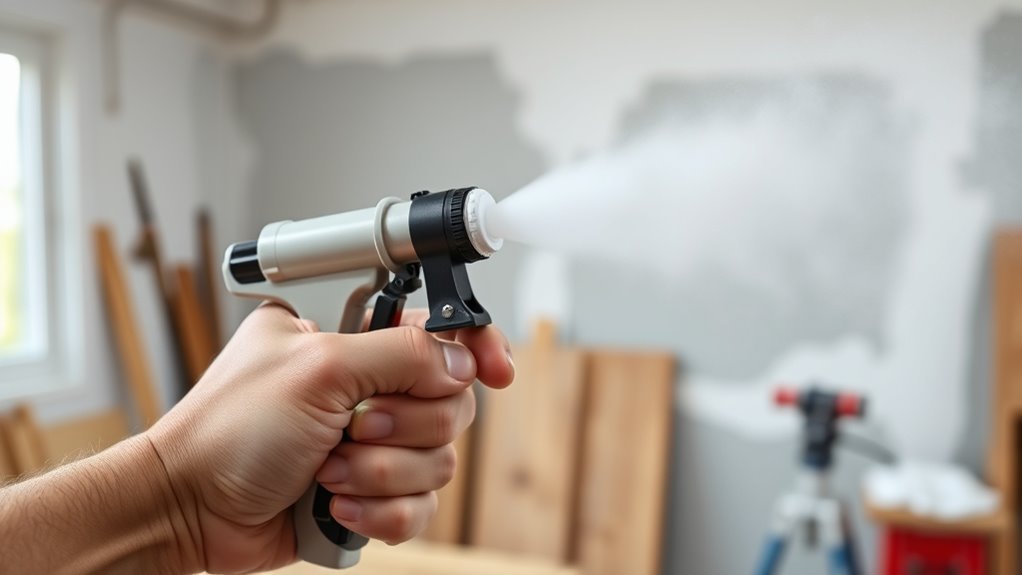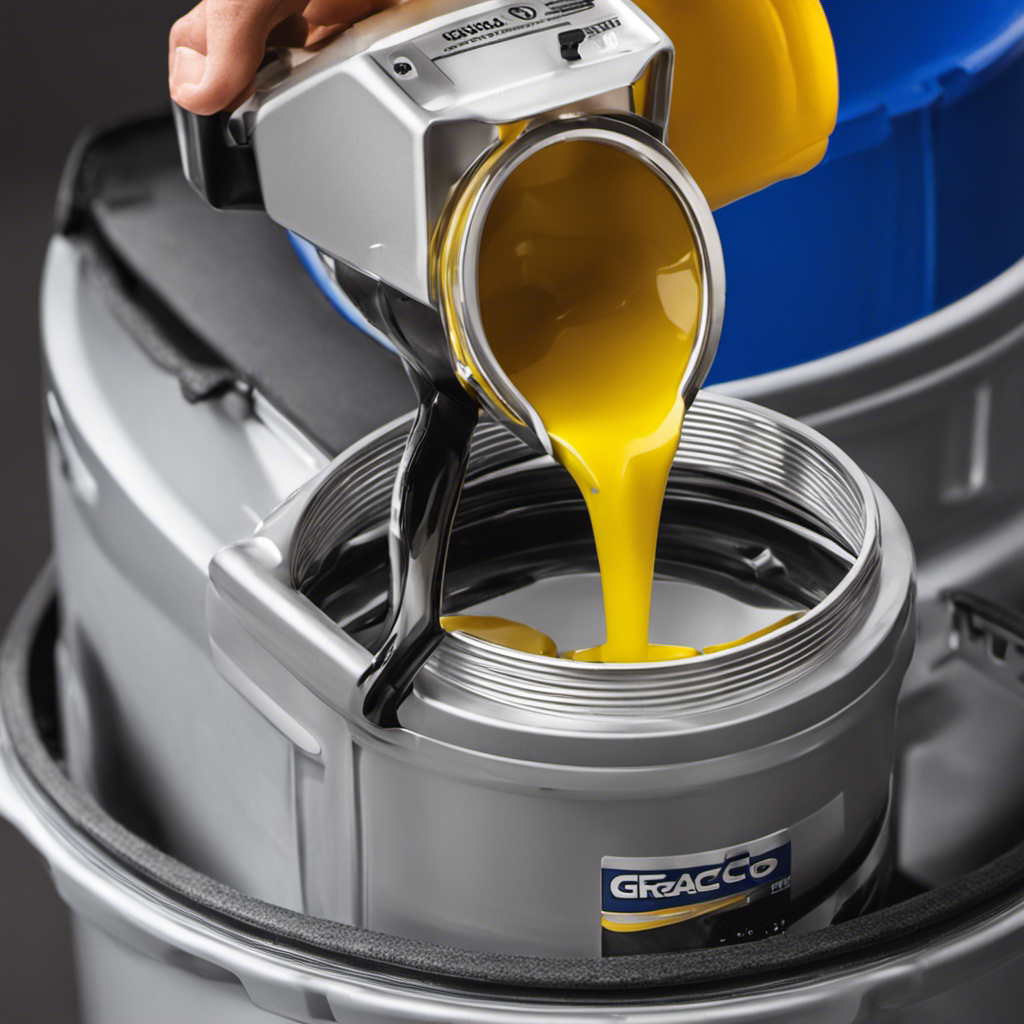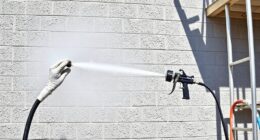Yes, you can definitely use a paint sprayer for small touch-up jobs. It’s a quick, efficient tool that delivers smooth, even coverage, often better than brushes or rollers. Sprayers are especially handy for tight spots and detailed areas, providing a professional finish with less effort. While setup may seem extensive for tiny patches, the results are worth it. Keep exploring to discover tips that will help you get the best out of your sprayer for small projects.
Key Takeaways
- Paint sprayers provide smooth, even coverage quickly, ideal for small touch-up projects.
- They are suitable for tight spots and intricate surfaces, offering precision beyond brushes.
- For minor chips or patches, traditional tools like brushes may be more practical and cost-effective.
- Proper maintenance ensures consistent results and prolongs sprayer lifespan for future small jobs.
- Evaluate project size and detail to determine if a sprayer’s setup is justified for small touch-ups.

When it comes to small touch-ups, a dedicated paint sprayer can make the job quicker and more precise. Unlike traditional tools like brushes or rollers, a paint sprayer delivers a smooth, even coat with less effort and minimal streaking. This is especially helpful when you’re dealing with tight spots or intricate surfaces where brushes and rollers might struggle to provide a seamless finish. Using a sprayer for small jobs not only saves time but also ensures a professional-looking result, even if you’re just tackling a few patches.
For small touch-ups, a paint sprayer offers quick, even, and professional results with less effort.
However, before jumping into a spray gun for small touch-ups, it’s helpful to understand the differences between a brush vs roller and a paint sprayer. Brushes are excellent for detailed areas and touch-ups, giving you control over small spots and edges. Rollers work well for larger, flat surfaces, providing a quick way to cover substantial areas uniformly. But when precision and speed are your priorities, a sprayer outperforms both by applying paint evenly across surfaces with minimal physical effort. It also reduces the risk of brush marks or roller lines, which can be visible in small, carefully finished sections.
That said, a paint sprayer requires some maintenance, particularly spray gun maintenance, to keep it performing at its best. After each use, you should thoroughly clean the spray gun and all its components to prevent paint from drying inside the nozzles or hoses, which can clog or impair spray quality. Using the right cleaning solutions for the type of paint you’ve used is essential—water-based paints need water for cleaning, while oil-based paints require solvents. Regularly inspecting the nozzle for wear and replacing worn parts ensures a consistent spray pattern and prevents uneven application. Proper maintenance not only prolongs the life of your sprayer but also guarantees smooth operation for future projects.
Additionally, understanding the performance capabilities of your paint sprayer can help you achieve better results and avoid overspray or uneven coverage. While a paint sprayer is fantastic for small touch-ups, it’s worth considering your specific needs. If you’re only fixing minor chips or small patches, a sprayer’s setup might seem like overkill compared to a quick brush or roller. But if you value speed, precision, and a flawless finish, investing in a sprayer and maintaining it well can make your touch-up work much easier and more professional. Remember, mastering spray gun maintenance is key to getting consistent results and extending the lifespan of your equipment. So, for your next small project, weigh the benefits of a sprayer against traditional tools, and don’t forget to keep your spray gun in top shape for the best possible finish.
Frequently Asked Questions
Are Paint Sprayers Suitable for Detailed or Intricate Touch-Up Work?
For detailed or intricate touch-up work, paint sprayers might not be your best choice. They often lack the precision needed for fine brush techniques, making it harder to attain clean edges and consistent color matching. While sprayers work well for large surfaces, you should opt for brushes or small rollers for precise control in small areas. This way, you guarantee a professional finish without overspray or uneven coverage.
Can I Achieve a Smooth Finish With a Paint Sprayer for Small Areas?
Did you know that 80% of painters find paint sprayers give a smoother finish than brushes? You can achieve a smooth finish with a sprayer for small areas if you focus on proper brush techniques and maintain the right paint consistency. Keep your sprayer at an even distance, avoid overloading it, and practice steady movements. This way, you’ll get a professional look, even in tight spots.
What Types of Paint Are Compatible With Portable Paint Sprayers?
When choosing a portable paint sprayer, you should consider paint compatibility and sprayer durability. Most sprayers handle latex, acrylic, and oil-based paints, but always check your model’s specifications. Thinner paints work best for smooth application, while thicker paints may clog the nozzle. Opt for a sprayer with durable materials to withstand frequent use. Properly matching your paint type guarantees a smooth finish and extends your sprayer’s lifespan.
How Do I Prevent Overspray During Small Touch-Up Projects?
Think of yourself as an artist, mastering delicate brush techniques to prevent overspray. To keep your small touch-up projects tidy, use masking methods to cover surrounding areas and control paint dispersion. Adjust your paint sprayer’s pressure and spray distance for precision. Practice on scrap surfaces first, ensuring minimal overspray. These steps help you achieve a clean finish, just like a skilled painter, without mess or waste.
Is There a Cleaning Process Specific to Small Paint Sprayers After Use?
After using your small paint sprayer, you should clean it thoroughly to prevent paint removal issues and guarantee it works well next time. Disassemble the parts, rinse them with water or solvent based on your paint type, and use a brush for stubborn spots. For storage tips, dry all parts completely to avoid rust, then store in a dry place. Proper cleaning and storage keep your sprayer in top condition for future touch-ups.
Conclusion
So, can you use a paint sprayer for small touch-up jobs? Absolutely. It’s quick, it’s efficient, and it’s precise. It saves you time, minimizes mess, and delivers a smooth finish. Whether you’re fixing a tiny nick or revitalizing a small wall, a paint sprayer makes the task easier, faster, and more professional-looking. So go ahead, embrace the convenience, enjoy the results, and transform your space with confidence.
Franz came aboard the Paint Sprayer Zone team with a background in both journalism and home renovation. His articulate writing style, combined with a passion for DIY projects, makes him an invaluable asset. Franz has a knack for breaking down technical jargon into easy-to-understand content, ensuring that even the most novice of readers can grasp the complexities of paint sprayers.










